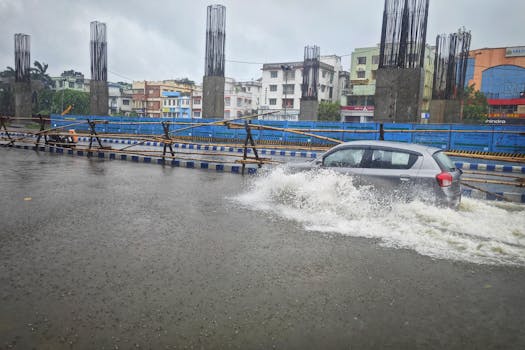
**
Hapur, Uttar Pradesh, finds itself battling a severe crisis following unprecedented heavy rainfall that has left large swathes of the city submerged in water. The monsoon's fury has exposed the city's inadequate drainage system, leading to widespread waterlogging and significant disruption to daily life. Residents are grappling with flooded homes, damaged property, and the looming threat of waterborne diseases. This situation highlights the urgent need for improved infrastructure and disaster preparedness in Uttar Pradesh.
Hapur Waterlogging: A City Submerged
The recent deluge has transformed Hapur's streets into canals, leaving vehicles stranded and homes inundated. Images circulating on social media depict scenes of widespread devastation, with residents wading through knee-deep water, desperately trying to salvage their belongings. The intensity of the rainfall, coupled with the city's poor drainage capacity, has resulted in a situation described by many as "catastrophic."
The Impact of the Floods
The impact of the waterlogging extends far beyond inconvenience. The following points highlight the severity of the situation:
- Disrupted Transportation: Roads and streets are impassable, bringing traffic to a standstill and severely hampering transportation networks. This has impacted access to essential services, including healthcare and education.
- Damage to Property: Homes and businesses are flooded, causing significant damage to property and belongings. Many residents have lost valuable possessions, leaving them with little to nothing.
- Health Concerns: Stagnant water poses a serious health risk, increasing the likelihood of waterborne diseases such as cholera, typhoid, and malaria. The lack of sanitation and hygiene adds to these concerns.
- Economic Losses: Businesses have been forced to close, causing significant economic losses for individuals and the city as a whole. The disruption to trade and commerce has a far-reaching impact.
- Power Outages: In several areas, power outages have compounded the problems, leaving residents without electricity and exacerbating the difficulties of dealing with the floodwaters.
Government Response to Hapur Flood Crisis
The Uttar Pradesh government has announced emergency relief measures, including the deployment of the National Disaster Response Force (NDRF) and State Disaster Response Force (SDRF) teams. These teams are working tirelessly to pump out water, rescue stranded individuals, and provide relief materials to those affected. However, the scale of the disaster means the relief effort is a monumental task.
Criticisms of Government Response & Infrastructure
Despite the government's efforts, criticism has been leveled at the slow response time and the apparent lack of preparedness. Many residents argue that the city's drainage infrastructure is woefully inadequate and has been neglected for years. The recurring nature of such flooding events underscores the need for long-term solutions. Calls are mounting for a thorough review of the city's urban planning and drainage systems.
The inadequacy of the drainage system in Hapur is not a new issue. Previous instances of heavy rainfall have resulted in similar waterlogging, yet no substantial steps appear to have been taken to address the underlying problems. This lack of proactive measures has compounded the suffering of the city's residents.
Long-Term Solutions Needed for Uttar Pradesh Cities
The Hapur waterlogging crisis is not an isolated incident. Many cities in Uttar Pradesh face similar challenges due to inadequate infrastructure and poor urban planning. The state government needs to adopt a comprehensive approach to address these issues, including:
- Investing in robust drainage systems: This requires significant investment in upgrading and expanding the existing drainage infrastructure to accommodate heavy rainfall.
- Improved urban planning: Future development should incorporate sustainable drainage systems and flood-resistant infrastructure.
- Early warning systems: Implementing effective early warning systems can help minimize the impact of future flooding events.
- Community engagement: Involving local communities in disaster preparedness and response efforts is crucial.
- Strengthening disaster management capacity: Training and equipping local authorities to effectively manage disaster situations is vital.
Hapur Flood: A Wake-up Call for Uttar Pradesh
The devastating floods in Hapur serve as a stark reminder of the vulnerability of Uttar Pradesh cities to extreme weather events. The situation underscores the urgent need for a comprehensive and proactive approach to disaster management and infrastructure development. The state government must act decisively to prevent similar crises from unfolding in the future, ensuring the safety and well-being of its citizens. The long-term consequences of inaction will be far greater than the immediate cost of addressing the infrastructure deficit. This is not just about managing the current crisis; it's about building a more resilient and sustainable future for Uttar Pradesh. The ongoing recovery efforts in Hapur, coupled with a long-term strategic plan, are essential to prevent a recurrence of this devastating event. The monsoon season is far from over, and preparedness is crucial for the safety and well-being of the people of Hapur and other vulnerable cities in Uttar Pradesh.




















